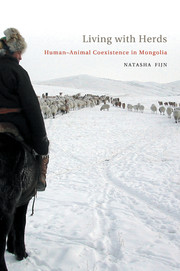Book contents
- Frontmatter
- Contents
- Lists of Plates, Figures, Maps, Tables, and Online Video Segments
- Glossary
- Acknowledgments
- LIVING WITH HERDS
- PART ONE CROSSING BOUNDARIES
- PART TWO THE SOCIAL HERD
- PART THREE LIVING WITH HERDS
- 7 IN THE LAND OF THE HORSE
- 8 THE CYCLE OF LIFE: BIRTH TO DEATH, SPRING TO WINTER
- 9 THE DOMESTIC AND THE WILD
- 10 THE SACRED ANIMAL
- CONCLUSION: CO-DOMESTIC LIVES
- Appendix
- References
- Index
- Plate section
CONCLUSION: CO-DOMESTIC LIVES
from PART THREE - LIVING WITH HERDS
Published online by Cambridge University Press: 03 May 2011
- Frontmatter
- Contents
- Lists of Plates, Figures, Maps, Tables, and Online Video Segments
- Glossary
- Acknowledgments
- LIVING WITH HERDS
- PART ONE CROSSING BOUNDARIES
- PART TWO THE SOCIAL HERD
- PART THREE LIVING WITH HERDS
- 7 IN THE LAND OF THE HORSE
- 8 THE CYCLE OF LIFE: BIRTH TO DEATH, SPRING TO WINTER
- 9 THE DOMESTIC AND THE WILD
- 10 THE SACRED ANIMAL
- CONCLUSION: CO-DOMESTIC LIVES
- Appendix
- References
- Index
- Plate section
Summary
What is animal “domestication” in Mongolia? On the basis of my experience living in the Khangai Mountains, I came to the view that Mongolian herding families and herd animals have developed co-domestic existences with one another. In adaptive terms, I suspect that both human and non-human animals have experienced symbiosis, or a co-evolutionary domestication process, through their profound influence upon one another over thousands of years. This long-term perspective, however, was not the primary focus of this book. Instead I have described a window into the herder–herd animal relationship in two valleys in the Khangai Mountains, within the lifetimes of specific individuals. My intention was to provide examples of how human and non-human live together through intercultural, interspecies existences in Mongolia.
Mongolian herders and herd animals rely on one another in a reciprocal relationship of co-dependence. While I was in the field, I realised how important the herd animals were to the herding families' everyday lives and ultimately for their survival. Herders refer to the co-domestic herd animals simply as the five kinds of animal, or tavan khoshuu mal (horses, cattle, sheep, goats, and camels), who are nurtured by and regularly engage with humans within the co-domestic sphere of the herding encampment. As Naraa succinctly put it, “We feed them and they feed us.”
- Type
- Chapter
- Information
- Living with HerdsHuman-Animal Coexistence in Mongolia, pp. 241 - 246Publisher: Cambridge University PressPrint publication year: 2011



